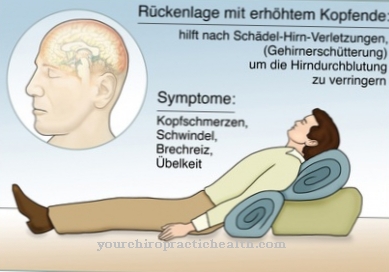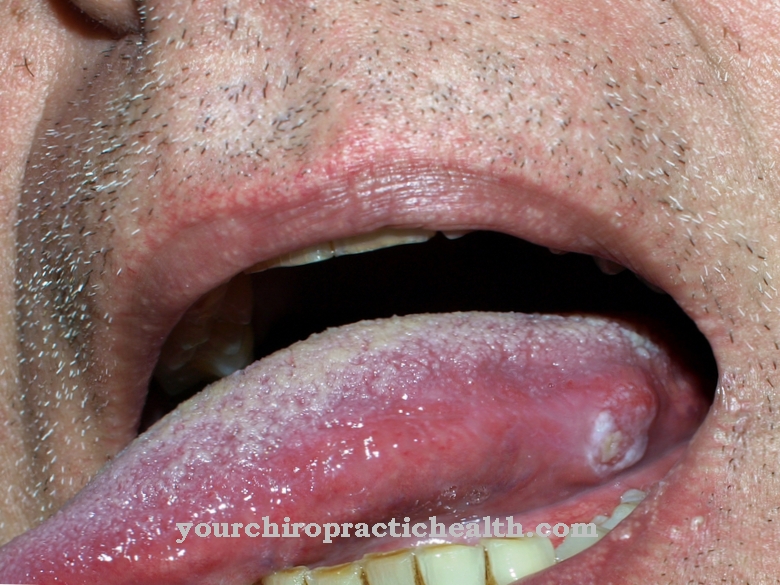Of the Hunter's disease belongs to the mucopolysaccharidoses (MPS). It is inherited in an x-linked recessive manner and therefore almost only affects boys and men. The course of the disease in individual patients is different.
What is Hunter Disease?

© olando - stock.adobe.com
Of the Hunter's disease is a hereditary lysosomal storage disease in which the breakdown of dermatan and heparan sulfate is impaired. Both polymers are macromolecules made up of a polysaccharide chain with a sulfate residue. This molecule is still bound to a glucoprotein. The polysaccharides are made up of different simple sugars.
Dermatan sulfate is involved in the structure of the cartilage tissue. Heparan sulfate takes on important tasks in the extracellular area. In Hunter's disease, these macromolecules are either not broken down or only insufficiently broken down. Since the compounds are first absorbed by the lysosomes before they are broken down, there is a constant accumulation of the substances in these cell organelles in the event of breakdowns.
The disease occurs very rarely. There is only one case out of 156,000 births. For Germany, that results in only four to five cases per year. Almost only boys and men are affected. The course of the disease is very different depending on the severity. There are cases with physical, motor and mental retardation. However, there are also milder cases that are so treatable that the symptoms can almost be suppressed.
causes
Hunter's disease is caused by a mutation on the X chromosome. The gene for the synthesis of the enzyme iduronate-2-sulfatase is defective. The enzyme is either not synthesized at all or only to a limited extent. Iduronate-2-sulfatase is responsible for splitting off the sulfate group from dermatan and heparin sulfate. This degradation is therefore no longer taking place or to an insufficient extent.
The two polymers are stored in the lysosomes. The lysosomes enlarge and ultimately the affected cells are destroyed. The disease is inherited in an x-linked recessive manner. This means that almost only boys and men can get sick. Girls and women have two X chromosomes. Since the gene can be inherited in a recessive manner, a healthy gene is sufficient to prevent the disease. However, boys and men only have one X chromosome and one Y chromosome, so that if the defective gene is inherited, there is no compensation by a healthy gene.
Symptoms, ailments & signs
Hunter's disease manifests itself through various symptoms. On the one hand, there are cases with severe mental retardation and, on the other hand, very mild forms of the course without mental impairment. Life expectancy can be reduced. But there are also cases with normal life expectancy. Often pale, nodular skin thickenings appear. The thickenings are usually grouped together.
Other symptoms include thick eyebrows, a protruding lower jaw, an enlarged tongue, a sunken bridge of the nose or fleshy lips. The voice is deep and hoarse. It can also lead to hearing loss. The joints deform progressively and skeletal changes occur. The abdomen is distended, and an enlargement of the liver and spleen can develop.
Growth retardation and umbilical hernias are other symptoms. There may also be paralysis of all four limbs. The heart is also affected. This can lead to heart failure.Heart failure is the main cause of death when the disease is severe. The symptoms arise from the enlargement of the cells due to the constant storage of dermatan and heparan sulfates in the lysosomes of the cells.
The disease can affect children and adolescents (type A). Then it usually comes to a severe course with mental retardation. However, sometimes the disease does not begin until adulthood (type B). In this case, the course is often very mild. However, there are also transitional forms between the two types. The success of the treatment also depends on the severity of the disease.
Diagnosis & course of disease
The diagnosis of Hunter's disease is made through laboratory tests. Urine analyzes are carried out for the mucopolysaccharides dermatan and heparan sulfate. The defective enzyme is determined in the leukocytes or in the fibroblasts. A molecular genetic analysis can also be carried out. The leukocyte DNA is determined.
A prenatal diagnosis of the corresponding mutation is also possible. Since the disease is progressive, regular lung function tests, echocardiographies, and orthopedic follow-ups are necessary.
Complications
Hunter's disease primarily results in very severe mental retardation. For this reason, those affected are almost permanently dependent on the help of other people. Relatives or parents often experience psychological complaints, moods or severe depression as a result of this illness.
Furthermore, the patients also suffer from hearing impairment and visual problems. It is not uncommon for changes to occur in the skeleton, so that there are restrictions in various movements. The growth and development of the child are significantly delayed and restricted by Hunter's disease, so that severe restrictions and complications occur, especially in adulthood.
Furthermore, this disease often leads to heart problems, so that those affected suffer from a greatly reduced life expectancy due to sudden cardiac death. A causal treatment is not possible in this case. A variety of therapies or stem cell transplants can limit certain symptoms.
The success and the further course of the treatment, however, depends heavily on the severity of Hunter's disease, so that it does not always lead to a positive course of the disease. However, there are no complications during treatment.
When should you go to the doctor?
Because of the genetic cause of Hunter's disease, almost exclusively boys and men belong to the risk group of the disease, parents should be particularly vigilant with their male offspring. If the symptoms only appear in adulthood, men should undergo a comprehensive examination as early as possible. It is preferable to take part in regular check-ups for early detection. If a child has growth retardation or developmental disorders, a doctor is recommended. If mental limitations or delays are found in direct comparison with children of the same age, a doctor should be consulted.
Targeted tests reveal discrepancies and can be clarified. Consult a doctor if the skin is abnormal, lumps on the skin or discolored. Umbilical hernias, paralysis or other mobility restrictions must be clarified immediately. The general risk of accidents and injuries is increased with Hunter's disease.
Therefore, complications should be minimized and a doctor's visit should be made as early as possible. If the daily tasks can no longer be carried out as usual or only with the help of other people, a doctor should be consulted. If the person concerned suffers from emotional or mental problems, a visit to the doctor is also recommended. Medical help is needed in the event of mood swings or periods of depression.
Therapy & Treatment
A causal treatment of Hunter's disease is not possible because it is a genetic disease. The success of a therapy varies from patient to patient. It also depends on the severity. In some cases, a stem cell transplant can be performed successfully. The drug Idursulfase with the trade name Elaprase has been approved in Europe since 2007.
Idursulfase, as iduronate-2-sulfatase, is the enzyme that is no longer functional in Hunter's disease. In some cases the enzyme treatments are producing good results. With this therapy a normal life expectancy can be achieved. Treatment must be lifelong. In very advanced cases, however, therapy is sometimes no longer promising. The aim here is to alleviate the symptoms.
You can find your medication here
➔ Medicines for painOutlook & forecast
The prognosis for those affected is very individual and different depending on the current severity. Since the disease is purely hereditary, Hunter's disease cannot yet be cured. Newly researched forms of therapy, such as a transplantation of blood-forming stem cells or gene therapy, can heal purely theoretically, but they are currently considered experimental. The course of the disease is very variable from patient to patient.
However, if the disease remains untreated, severe forms of the disease can lead to death before the affected person is five years old. Even with the lighter forms, many of the patients die before they reach adulthood. Particularly non-neuronopathic types of Hunter's disease can, however, be treated very well by means of enzyme replacement therapy and together with the therapy of the disease symptoms.
Since the cause of the disease is a genetic defect, affected couples who want to have children should seek advice in a genetic consultation. During pregnancy, an amniocentesis and a chorionic villus sampling can also be used to determine whether the gene for Hunter's disease is defective in the offspring. The life expectancy of the sick is normal to limited. In most of the cases, the mortality is due to the cardiopulmonary complications.
prevention
It is not possible to prevent Hunter's disease. It is a hereditary condition. If the family has already had cases of this disease and wishes to have children, genetic counseling should be sought in order to assess the risk. A prenatal genetic examination is also possible. If the disease already exists, it is important to have thorough examinations carried out. Therapy should start early in order to successfully accompany the disease.
Aftercare
Hunter's disease is a hereditary disease and so far not curable. The course of the disease is very individual depending on the severity, but the patients require lifelong treatment. In order to alleviate discomfort and improve general well-being, those affected can take some measures themselves.
In the case of neurological complaints, targeted physiotherapy and exercise can have a positive effect on the general condition. Gentle sports like gymnastics and swimming help to maintain or improve the mobility of the affected limbs. Psychological complaints increase in the course of the illness and can be treated with psychotherapy.
Medical emergencies such as acute heart failure can often occur with Hunter's disease. In the event of an emergency typical for this disease, the emergency services must be called. Until the emergency doctor arrives, first aiders should provide first aid and, if necessary, carry out resuscitation measures. Hunter's disease is fatal sooner or later, depending on the severity.
Comprehensive therapeutic treatment, supplemented by a healthy lifestyle and discussions with other affected people, can improve the patient's quality of life. As a rule, it helps those affected to cope better with their illness if they are sufficiently informed about symptoms, complaints, causes and consequences. Regular discussions with the specialist are also part of the therapy. Medical advice supports sufferers in dealing with Hunter's disease on a daily basis.
You can do that yourself
Hunter's disease is currently not curable. Patients can still take some measures to alleviate the symptoms and improve their wellbeing.
In the case of neurological complaints, in addition to therapy and physiotherapy, exercise is also an option. Swimming and aerobics help improve the mobility of the affected limbs. The increasing psychological complaints are dealt with as part of psychotherapy. In the event of acute heart failure or any other emergency typical of the disease, the emergency services must be called. Until the emergency doctor arrives, the first aiders must provide first aid and, if necessary, attempt to resuscitate them.
Hunter's disease is usually fatal. This makes comprehensive therapeutic treatment all the more important, supported by discussions with other affected persons and a healthy and active lifestyle. The sick can often cope better with the disease after they have informed themselves in detail about the symptoms, complaints, causes and consequences. Regular discussions with a specialist are therefore essential, especially in the early stages of the disease. The medical professional can provide further tips on how the patient can support Hunter's disease therapy.


.jpg)



.jpg)






.jpg)

.jpg)
.jpg)











.jpg)